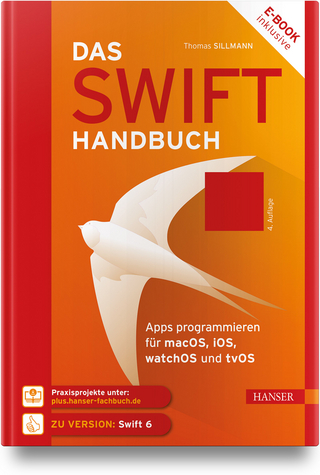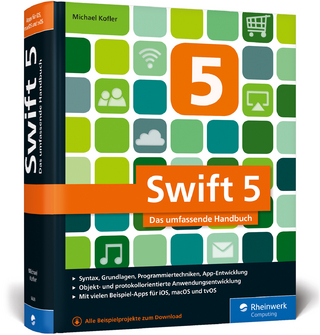
Xcode 4
John Wiley & Sons Inc (Verlag)
978-1-118-00759-4 (ISBN)
- Titel ist leider vergriffen;
keine Neuauflage - Artikel merken
Everything you need to know to design, code, and build amazing apps Xcode 4 is Apple s newest version of the popular development suite for creating bleeding-edge OS X and iOS apps. Written by an experienced developer and Apple-focused journalist, this book not only covers developing for OS X but also for the entire family of iOS devices, including the iPhone , iPad, and iPod touch. You ll explore the newest tools for compiling, debugging, and finding and fixing common code errors so that you can look forward to improved, smooth-running code that is developed more efficiently than ever. Takes you step-by-step through the process of developing OS X and iOS applications using Xcode 4 Examines the benefits of Xcode 4, Apple s updated, free, object oriented programming environment Helps you tame the complex Xcode environment so you can develop amazing apps This book gets you up to speed on all the remarkable new features and redesigned user interface of Xcode 4 so you can get started creating phenomenal apps today.
Richard Wentk is a professional developer, and a technology writer with more than fifteen years experience in publishing. He covers Apple products and developments for MacWorld UK and MacFormat magazines, writes about technology and business strategy, and is the author of the popular Cocoa in Wiley's Developer Reference series.
Preface xvii Acknowledgments xix Introduction xx Part I: Getting Started 1 Chapter 1: Introducing Xcode 4 3 Understanding the History of Mac Development Tools 4 Looking back at early IDEs 4 Developing Xcode 5 Understanding Xcode 4 s Key Features 7 Moving to Xcode 4 9 Moving from the Xcode 3 to the Xcode 4 editor 10 Working with Interface Builder 16 Exploring code and file management 17 Exploring the debugger 19 Comparing iOS and OS X Development 20 Developing for OS X 20 Developing for iOS 22 OS X and iOS cross-development 23 Summary 24 Chapter 2: Getting and Installing Xcode 25 Selecting a Mac for Xcode 25 Choosing a processor 25 Selecting memory 26 Choosing a monitor 26 Working with disk storage 27 Choosing peripherals 28 Choosing supporting software 29 Signing Up for Development 30 Registering as a developer 31 Choosing a program 32 Accessing developer resources 36 Getting Started with Xcode 38 Installing Xcode 39 Creating and organizing project folders 42 Working with multiple versions of Xcode 44 Uninstalling Xcode 45 Summary 45 Chapter 3: Building Applications from Templates 47 Getting Started with Templates 47 Building a project from an application template 50 Looking inside the Application templates 57 Using the OS X Application templates 58 Understanding the iOS Application templates 62 Introducing the Framework and Library templates 69 Introducing Plug-in templates 70 Changing the Standard Templates 71 Finding the template files 71 Customizing the template files 72 Summary 74 Chapter 4: Navigating the Xcode Interface 75 Understanding the New Interface 75 Using the Navigation Area 77 The Project Navigator 77 The Symbol Navigator 79 The Search Navigator 82 The Issue Navigator and the Log Navigator 84 The Breakpoint Navigator and the Debug Navigator 88 Loading the navigators from menus and keyboard shortcuts 89 Using the Utility Area 90 Displaying file information 90 Using Quick Help 92 Using the library area 93 Working with the Editor Area 94 Getting started with code editing 95 Introducing build configurations 99 Summary 102 Chapter 5: Working with Files, Frameworks, and Classes 103 Working with Files and Classes 103 Adding new files to a project 104 Adding a new class 111 Adding new resources 112 Adding miscellaneous other files from the templates 112 Deleting and renaming files 113 Importing existing files 115 Reimporting missing files 116 Working with Groups 117 Moving groups and files 117 Creating a new group 118 Organizing groups 119 Working with Frameworks 119 Using frameworks 120 Adding existing frameworks 121 Summary 122 Chapter 6: Using Documentation 123 Understanding the Apple Documentation 125 Comparing iOS and OS X and their different versions 125 Understanding resource types 126 Using topics 136 Using frameworks and layers 138 Searching the online documentation 139 Using the Xcode Documentation Viewer 140 Browsing the documentation 141 Searching the documentation 143 Using class references 145 Accessing documentation from code 146 Using Other Documentation 148 Summary 149 Chapter 7: Getting Started with Interface Builder 151 Understanding IB 151 Understanding nib files 152 Using nib files 153 Getting Started with IB 156 Introducing key features of the editor 156 Viewing the template nib files 158 Introducing the utility area 159 Creating a Simple iOS Project with IB 163 Adding objects to a view 165 Setting object contents 167 Linking objects to code 176 Understanding the IB object hierarchy 186 Comparing IB in Xcode 4 with Xcode 3 188 Summary 188 Chapter 8: Creating More Advanced Effects with Interface Builder 189 Using File s Owner and First Responder 189 Using File s Owner 189 Using First Responder 191 Subclassing Views and Other Objects 193 Adding a new subclass in Xcode 194 Adding code to the subclass 196 Assigning the subclass in IB 198 Working with more advanced subclassing techniques 200 Creating Custom Objects 202 Creating Views with Static Images 202 Creating a colored background 203 Importing an image file 204 Assigning an image file 207 Supporting Non-English Languages 209 Working with Advanced IB Techniques 212 Using tags 212 Sending messages between nibs 213 Converting iPhone projects to the iPad 214 Summary 217 Part II: Going Deeper 219 Chapter 9: Saving Time in Xcode 221 Using Code Folding 221 Editing Structure 223 Refactoring Code 225 Using the Refactor menu 226 Using the Edit All In Scope feature 228 Using Code Snippets 229 Inserting a snippet 229 Creating a new snippet 230 Jumping to a Definition 232 Summary 233 Chapter 10: Using the Organizer 235 Working with Devices 235 Reviewing and managing profiles 237 Working with software images 239 Finding and installing iOS updates 240 Using device logs 241 Working with screenshots 244 Managing individual devices 246 Working with Projects and Archives 252 Managing Projects 252 Creating Archives 254 Summary 255 Chapter 11: Managing Certificates and Provisioning 257 Understanding Provisioning 257 Creating and Installing User Certificates 262 Creating a CSR 263 Uploading the CSR to the Provisioning Portal 265 Creating and downloading a development certificate 268 Creating and downloading a distribution certificate 268 Installing the certificates 269 Provisioning Devices Manually 271 Creating an App ID 272 Registering devices manually 277 Creating a Development Provisioning Profile 280 Creating a Distribution Provisioning Profile 283 Automatic Provisioning 285 Creating an automatic device profile 285 Refreshing a profile 286 Moving between Macs 287 Provisioning for OS X Distribution 288 Understanding OS X provisioning 289 Provisioning in practice 290 Summary 297 Chapter 12: Working with Builds, Schemes, and Workspaces 299 Getting Started with the Xcode Build System 299 Creating and organizing a workspace 301 Working with projects and targets 302 Understanding settings and options 304 Working with Schemes and Build Configurations 311 Getting started with build configurations 311 Understanding schemes 315 Editing schemes 316 Managing schemes, build actions, and targets 325 Summary 328 Chapter 13: Customizing Builds for Distribution and Advanced Development 329 Introducing Common Basic Customizations 329 Creating a build for testing and debugging 330 Selecting the Base SDK 330 Setting the minimum supported OS version 331 Including a framework or library in a build 336 Selecting a compiler 337 Controlling warnings 338 Disabling iOS PNG compression 339 Changing an app s name before shipping 339 Creating App Store and Ad Hoc Builds 341 Building and packaging an iOS project for the App Store 341 Creating and distributing an iOS Ad Hoc build 357 Creating a Mac App Store submission 361 Working with Advanced Build Techniques 368 Understanding the build process 369 Introducing conditional compilation 370 Using conditional compilation 370 Understanding build phases and build rules 374 Working with build phases 374 Creating build rules 379 Summary 382 Chapter 14: Using Version Control 383 Using Manual Version Control 383 Using Snapshots 385 Working with Source Control 388 Understanding Git 389 Using Git locally 390 Using Xcode with GitHub 405 Summary 414 Part III: Creating Fast and Reliable Code 415 Chapter 15: Getting Started with Code Analysis and Debugging 417 Checking and Analyzing Code 418 Checking code as you enter it 418 Using Fix-It code tips 419 Using the Static Code Analyzer 420 Getting Started with Debugging 422 Using the Console 423 Creating custom messages 424 Using custom messages 425 Understanding crashes 426 Viewing multiple logs 429 Working with Breakpoints 430 Working with simple breakpoints 430 Using the Variables View 434 Using advanced breakpoint features 441 Working with Command-Line Debugging 446 Summary 448 Chapter 16: Testing Code with Instruments 449 Beginning with Instruments 450 Understanding Instruments 451 Exploring the Instruments UI 451 Getting Started with Instruments 458 Creating a leaky test app 459 Profiling an app with Instruments 460 Exploring the detail pane 475 Modifying instrument settings 476 Comparing different runs 479 Saving and loading runs 480 Working with Instruments and Templates 480 Understanding templates 480 Creating a template 480 Creating custom instruments 482 Working with UIAutomation 484 Setting up objects to support automation 485 Creating a test script 486 Getting started with Automation scripting 488 Summary 491 Chapter 17: Creating Unit Tests 493 Introducing Unit Testing 493 Understanding Unit Testing in Xcode 494 Creating a Simple Unit Test Project 496 Creating a new project that supports unit testing 497 Creating a class for testing 499 Creating a test case 502 Running tests 508 Summary 512 Part IV: Appendixes 513 Appendix A: Using Xcode s Tools and Utilities 515 Appendix B: Working with Other Editors 527 Appendix C: Understanding Compiler Technology 549 Index 557
| Reihe/Serie | Developer Reference |
|---|---|
| Zusatzinfo | Illustrations |
| Verlagsort | New York |
| Sprache | englisch |
| Maße | 188 x 238 mm |
| Gewicht | 1184 g |
| Einbandart | Paperback |
| Themenwelt | Mathematik / Informatik ► Informatik ► Betriebssysteme / Server |
| Informatik ► Programmiersprachen / -werkzeuge ► Mac / Cocoa Programmierung | |
| Informatik ► Weitere Themen ► Hardware | |
| ISBN-10 | 1-118-00759-X / 111800759X |
| ISBN-13 | 978-1-118-00759-4 / 9781118007594 |
| Zustand | Neuware |
| Informationen gemäß Produktsicherheitsverordnung (GPSR) | |
| Haben Sie eine Frage zum Produkt? |
aus dem Bereich

